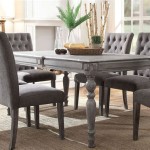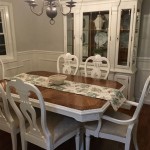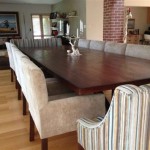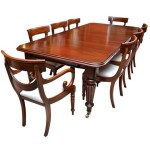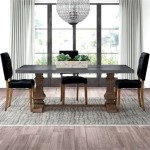L-Shaped Bench Dining Table: A Space-Saving and Social Seating Solution
The L-shaped bench dining table represents a functional and aesthetically pleasing alternative to traditional dining sets. Characterized by a table accompanied by an L-shaped bench, this configuration offers numerous advantages, particularly in maximizing space utilization and fostering a more communal dining environment. This article explores the key features, benefits, design considerations, and practical applications of L-shaped bench dining tables.
Space Optimization and Versatility
One of the primary advantages of an L-shaped bench dining table is its ability to optimize space, particularly in smaller dining rooms or kitchens. Unlike traditional dining setups where individual chairs occupy significant floor space, the L-shaped bench nestles neatly into corners, creating a more compact footprint. This design liberates valuable floor area, making the room feel more spacious and allowing for easier movement. Furthermore, the bench seating eliminates the need for multiple chairs, which can often clutter a dining area. The design minimizes visual clutter, especially when the bench is pushed flush against the walls.
The versatility of an L-shaped bench dining table extends beyond space saving. The bench itself often provides hidden storage underneath the seating surface. This is particularly advantageous in apartments or homes where storage space is limited. The storage compartment can be used to store dining essentials such as placemats, napkins, or even serving dishes. The bench can also be designed with a hinged top or drawers, allowing for easy access to the storage space. In addition, the L-shaped configuration offers flexibility in accommodating varying numbers of diners. The bench can comfortably seat multiple people, and additional chairs can be added at the open end of the table to accommodate larger gatherings, making it adaptable to different occasions.
The spatial efficiency of the L-shaped bench also lends itself well to open-plan living arrangements. In these layouts, the dining area often flows seamlessly into the living room or kitchen. An L-shaped bench dining table can serve as a visual divider, defining the dining space without obstructing the flow of movement. The bench can also be positioned to create a natural transition between the dining area and another zone, enhancing the overall cohesion of the open-plan space. This integration further demonstrates the design’s adaptable and contemporary aesthetic.
Beyond the interior, an L-shaped bench dining table can extend the dining experience outdoors. On patios, decks, or balconies, this arrangement creates a comfortable and inviting space for al fresco dining. The bench seating encourages a relaxed and sociable atmosphere while maximizing the use of limited outdoor space. Weather-resistant materials such as teak, cedar, or synthetic wicker are ideal for outdoor L-shaped bench dining tables, ensuring durability and longevity.
Promoting Social Interaction and Communal Dining
Beyond its space-saving attributes, the L-shaped bench dining table significantly enhances social interaction and fosters a more communal dining experience. The bench seating encourages a closer proximity among diners, facilitating conversation and a sense of collective engagement. This arrangement contrasts with the traditional individual seating of chairs, which can sometimes create a more formal and less interactive atmosphere. The shared seating surface naturally promotes a feeling of togetherness and camaraderie, especially beneficial for family meals or gatherings with friends.
The design also enhances the inclusive nature of meals. Because the seating is continuous, there is less of a hierarchical seating arrangement. Everyone is on the same level and in closer proximity, which can be beneficial for fostering equality and open communication during meals. The L-shape naturally creates a focal point, drawing everyone's attention towards the center of the table and encouraging shared experiences.
The communal aspect of an L-shaped bench dining table is particularly advantageous for families with children. The bench seating allows parents to easily assist young children during meals, reaching across the table to help with setting up or serving food. It also encourages children to interact with each other and engage in conversation, fostering a sense of family unity. Furthermore, the bench seating can provide a safe and comfortable space for children to sit and eat, reducing the risk of them falling off chairs.
The relaxed and informal atmosphere fostered by the L-shaped bench dining table extends beyond family meals. It is equally well-suited for casual gatherings with friends, creating a comfortable and inviting space for sharing food and conversation. The bench seating encourages a more relaxed posture and allows diners to lean back and relax, fostering a more informal and convivial atmosphere. This makes it ideal for potlucks, game nights, or any social event where a relaxed and sociable setting is desired.
Design Considerations and Material Choices
The design possibilities for L-shaped bench dining tables are virtually limitless, allowing for customization to suit different aesthetic preferences and functional needs. A wide range of materials can be used for both the table and the bench, each offering unique characteristics in terms of durability, appearance, and maintenance. The choice of materials should be carefully considered to ensure that the dining table complements the overall decor of the room and meets the specific requirements of the users.
For the tabletop, popular materials include solid wood, wood veneer, laminate, glass, and stone. Solid wood offers a timeless aesthetic and exceptional durability, making it a popular choice for many homeowners. Wood veneer, consisting of a thin layer of solid wood glued to a core material, provides a similar look and feel at a more affordable price point. Laminate is a durable and easy-to-clean option, available in a wide range of colors and patterns. Glass tabletops offer a sleek and modern look, while stone tabletops provide a touch of luxury and sophistication. Each material presents its own set of advantages and disadvantages, depending on the desired aesthetic, budget, and maintenance requirements.
The L-shaped bench seating can be constructed from similar materials as the tabletop, or it can be upholstered with fabric, leather, or other materials for added comfort. Upholstered benches offer a softer seating surface and can be customized with different colors, patterns, and textures to complement the overall decor. The choice of upholstery material should consider factors such as durability, stain resistance, and ease of cleaning. Fabrics such as microfiber, canvas, and faux leather are popular choices for their durability and ease of maintenance. Real leather offers a luxurious look and feel, but requires more careful maintenance.
The legs of the table and bench can be made from wood, metal, or a combination of both. Wooden legs offer a warm and natural look, while metal legs provide a modern and industrial aesthetic. The design of the legs can also influence the overall style of the dining table, with options ranging from simple and minimalist to more ornate and decorative. The structural integrity of the legs is crucial for stability and should be carefully considered during the design process.
Ergonomics should be a key consideration in the design of an L-shaped bench dining table. The height of the table and bench should be carefully chosen to ensure that diners are comfortable and can sit properly. The bench seat should be deep enough to provide adequate support, and the backrest (if present) should be angled for optimal comfort. Armrests can also be added to the bench for added support and comfort, particularly for longer meals. The corners of the table and bench should be rounded to prevent accidental bumps and injuries. These ergonomic considerations contribute to the overall functionality and usability of the dining table.
Beyond the choice of materials and ergonomics, the overall style of the L-shaped bench dining table should complement the existing decor of the room. The design can range from traditional to contemporary, depending on the desired aesthetic. A traditional design might feature ornate detailing, carved legs, and a wood finish. A contemporary design might incorporate clean lines, minimalist shapes, and modern materials such as glass and metal. The choice of style should be carefully considered to ensure that the dining table harmonizes with the overall design of the room.
Lighting plays a critical role in enhancing the dining experience. A well-placed pendant light above the L-shaped bench dining table can create a focal point and provide ample illumination for meals. Adjustable lighting can also be used to create different moods and atmospheres, depending on the occasion. Natural light should also be maximized, with windows and skylights strategically positioned to allow for ample sunlight during the day. The combination of natural and artificial light can create a warm and inviting dining environment.

Corner Banquette Dining Set Modern L Shape Seating V Table Etsy

Linon Home Decor Rockhill 2 Piece L Shaped White And Natural Wood Top Nook Dining Room Set Seats 4 Thd02821 The

Small L Shaped Bench Design Ideas

Chintaly Linden L Shaped Dining Bench

Banquette L Shaped Bench Tutorial With Free Building Plans Reality Daydream

Kitchen Peninsula With L Shaped Dining Bench Transitional Room

Driftwood Base Custom L Shape Banquette Bench Dining Nook Booth Etsy

Blue L Shaped Bench At Oval Oak Dining Table Transitional Room

L Shaped Breakfast Table

Oval Pedestal Dining Table With L Shaped Bench Vintage Room


